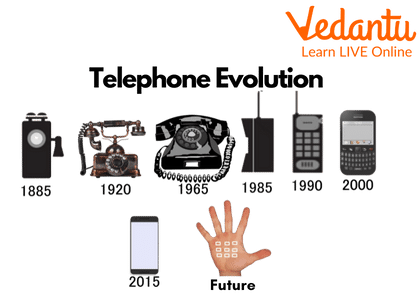




Information About Telephone
The telephone is one such device that changed the equation of the whole world. Any person who has to convey his point of view to another person sitting far away, can call from the telephone in a few seconds and speak his point. If there was no telephone, even today we would have to go to the pigeon. The entire credit for making our needs easy is to go to the telephone itself. The telephone has established the whole world in one centre. Today we can call and talk to whomever we want in a few seconds.

The Telephone.
What is a Telephone?
Telephone, also known as "phone". It is a telecommunication device that sends and receives sounds like voice messages and data over a certain distance. The word telephone is derived from the Greek word tele, meaning far, and phone, meaning voice or sound. In the broadest sense, the Telephone is a specific type of telecommunications that allows people to have direct conversations over almost any distance.
History of Invention and Evolution of Telephone
Not everyone agrees on who invented the telephone. However, it is usually attributed to Alexander Graham Bell. In 1876, he sent the first word by telephone. Later that year Bell made the first long-distance call. He spoke to his assistant, who was 2 miles (3.2 kilometres) away. By 1915 people could make telephone calls across the United States. Telephone service began in the Atlantic Ocean in 1927. The first cell phones appeared in the late 1970s.

Alexander Graham Bell.
Around the same time advances in electronics made the telephone useful for more than just talking. Fax machines became common in the 1970s. They use telephone wires to send words and pictures. Today many computers connect to the Internet via telephone lines.

Evolution of the Telephone.
How Does the Telephone Work?
The telephone has two main parts, the first is the speaker and the hearing aid. Its end which is spoken by keeping it near the mouth is called 'Mike'. And the other end, which we attach to the ear, is called the 'receiver'. The second part is the telephone machine from which the numbers are dialled.
When we telephone someone, the mic in the first part of the telephone converts our voice into electrical waves. When these waves reach the other person's receiver, they are converted into sound again. The work of converting sound into electrical waves and electrical waves into voice is done by a very thin metal plate in the mic and receiver of the telephone, which we call a 'diaphragm'.
When our voice hits the diaphragm, it starts vibrating. Due to this vibration, the current running in it also slows down. When this current reaches the other person's receiver in the diaphragm, then it also vibrates as before, as a result of which we can hear the sound.
Cordless Telephone and Cell Phone
Cordless Telephone:
A cordless telephone is more suitable than a traditional telephone. There is no cord connecting the handset and the base. This allows one person to move around the house while talking.
A cordless telephone uses both electrical signals and radio waves. It receives calls in the form of an electric signal, just like corded phones do. The base then converts the electrical signal into radio waves. Using antennas, the base sends waves through the air to the handset. The antenna of the handset picks up the waves. The handset then converts the waves back into sound.
Cell Phone:
Cell phones are even more convenient than cordless phones because they work over a much wider area. For this reason, in some places, they are also called mobile phones. They send and receive calls using radio waves.
Cell phone companies divide an area, such as a city, into sections called cells. Each cell has a tower for receiving and sending radio waves. If the caller moves from one cell to another, the call is switched from tower to tower. This means that a cell phone can work anywhere the cell phone company's network is reached. Cell phone networks can spread across the country.
A cell phone sends a special signal whenever it is turned on. The signal tells the network where to send incoming calls to that phone.
Many cell phones can do other things than make calls. Can send text messages to most other cell phones. Many people can take pictures, play music, get information from the Internet, and send and receive emails. Some types, called smartphones, also run computer programs called applications. Apps let people play games, shop, read, get maps and directions, set appointments, and many more. For those reasons, smartphones are like handheld computers.
Solved Questions
1. How is the Telephone used in communication?
Ans: The Telephone is used for 'Communication'. The telephone consists of two essential parts: a microphone and a speaker. This allows the user to speak into the device and listen to broadcasts from another user.
2. What is meant by Telephone conversation?
Ans: We can define telephone conversation as the exchange of information between two persons over the telephone. It is not a face-to-face conversation but a person-to-person conversation where no one sees the other but listens to each other and interacts instantly.
Learning By Doing
Telephone for Kids:
How to make a Telephone? We can make a Telephone by using 2 paper cups. Like Shown in the picture given below. Ask your teachers to help you. And understand the whole procedure of this activity.

Paper Cup Telephone.
Summary
The telephone is a telecommunication device. It is a specific type of telecommunications that allows people to have direct conversations over almost any distance. The Telephone has two main parts, a microphone and a receiver. When we telephone someone, the mic in the first part of the telephone converts our voice into electrical waves. When these waves reach the other person's receiver, they are converted into sound again.
FAQs on How Telephone Works
1. How does a landline telephone work in simple steps?
A landline telephone works by converting sound into electricity and back again. When you speak into the microphone, your voice's sound waves are turned into an electrical signal. This signal travels through physical wires to the other person's phone. There, the earpiece converts the electrical signal back into sound waves, so they can hear you.
2. What are the main parts of a traditional telephone?
A traditional telephone has a few key parts that help you communicate:
- Transmitter (Microphone): This is the part you speak into. It captures your voice and changes the sound waves into electrical signals.
- Receiver (Earpiece): This is the part you listen from. It changes the incoming electrical signals back into sound.
- Dialer (Rotary or Keypad): This is used to enter the phone number of the person you want to call.
- Switch Hook: This connects and disconnects the phone from the network. When you lift the receiver, the phone becomes active.
3. What is the main difference between a telephone and a mobile phone?
The main difference is how they connect. A traditional telephone (or landline) is connected by a physical wire to a network and can only be used in one fixed location, like a home or office. A mobile phone is wireless; it connects to the network using radio waves sent to and from nearby cell towers, allowing you to use it almost anywhere.
4. When did the telephone first come to India?
The telephone first came to India in 1881. The first formal telephone service was established in Calcutta (now Kolkata) in that year, shortly after Alexander Graham Bell invented the telephone.
5. How did Alexander Graham Bell's very first telephone work?
Alexander Graham Bell's first successful telephone worked using a principle called electromagnetic induction. It used a diaphragm (a thin metal disc) that vibrated when someone spoke near it. These vibrations moved a magnet near a coil of wire, which created a changing electric current. This electrical signal travelled along a wire to a receiver, where the process was reversed to recreate the sound. It was a direct conversion of sound energy into electrical energy and back.
6. Why is it important to follow telephone etiquette?
Telephone etiquette is important because the person you are talking to cannot see your facial expressions or body language. Your tone of voice and the words you choose are the only ways to convey your message clearly and politely. Good etiquette, like speaking clearly, listening without interrupting, and being respectful, prevents misunderstandings and ensures a positive conversation.
7. What is the role of a telephone exchange in making a call?
A telephone exchange acts like a central hub or a 'traffic controller' for phone calls. When you dial a number, a signal is sent to your local exchange. The exchange's job is to find the correct path to the person you are calling and connect your line to their line. Without the exchange, every phone would need a separate wire going to every other phone, which would be impossible.









